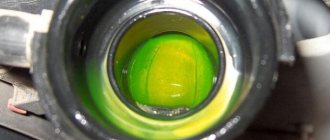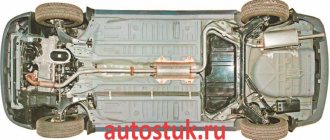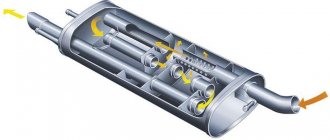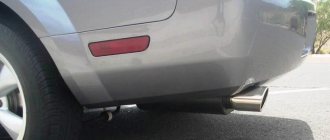How to detect soot in the muffler
It’s worth making a retreat right away; a small amount of soot in the muffler is acceptable. It can form over time. This soot is more like dust, and its layer can be easily removed, usually with a rag in one pass. However, if you see a build-up in the form of a black ring at the end of the pipe or a layer of soot in its inner part is more than 1 mm, there is most likely a malfunction in the engine.
This defect can be detected by simple visual inspection. For greater clarity, you can carefully run a wooden stick along the inner ring of the pipe. If soot covers the entire pipe, then it’s worth visiting a specialized service station to diagnose or repair the motor.
Often this phenomenon is discovered after refueling at unfamiliar gas stations. This does not greatly affect the driving performance of the car. There are no changes in dynamics or power. But soot appears in the pipe, and this is a bad sign.
Why does soot occur?
The main reason is incomplete combustion of fuel in the engine. More precisely, the engine runs on a richer fuel mixture, as a result of which its complete combustion does not occur. Some of the gasoline burns outside the engine and the soot is not removed naturally, but remains in the exhaust system.
A rich mixture can form for several reasons:
Due to poor quality fuel. Dilute gasoline does not have the desired detonation. For full operation of the engine, more fuel is required. Sensors that support the desired power parameters believe that the mixture needs to be enriched. The result is a larger volume of fuel, some of which is exhausted.
Due to a malfunction of one or more sensors. Most often, a breakdown occurs in the lambda probe, which is responsible for supplying fuel to the engine.
Due to incorrect or incorrect operation of the spark plugs. In this case, the fuel simply does not burn out from a bad spark.
Due to a dirty air filter. The engine chokes, it requires more power, and more fuel enters the system.
However, the presence of black soot in the pipe does not always indicate a serious malfunction in the engine. Most often, such things can be fixed without repairing the internal combustion engine.
Soot from the exhaust pipe, gasoline causes – Soot from the exhaust pipe, gasoline, causes of breakdown
| geer : |
| yellow-ff2 I also have such garbage |
Now all that remains is to figure out if this is normal?
Here is a link to the article - https://injector.in.ua/ru_articles_lambda-zond.html
Fragment from the article:
“Sometimes there is a malfunction of the lambda probe (lambda), causing voltage surges of negative polarity.
In the event of such a malfunction, fuel consumption increases greatly, engine response is significantly reduced, and during sudden acceleration, soot emissions from the exhaust pipe are observed.
, the working surface of the spark plug insulators becomes covered with soot.
Is the presence of black plaque always a sign of malfunction?
Black plaque is not always a wake-up call. Sometimes soot occurs due to an incorrectly tuned engine. For example, when the distributor in the car is set incorrectly, for later ignition. This drawback can be eliminated yourself by placing the distributor in a different position.
In some cases, you can simply try cleaning or replacing the spark plugs and changing the air filter.
Sometimes soot formation can occur when the car is parked for a long time and. In this case, the engine also runs on a richer mixture, which leads to the formation of a small amount of soot and is not a malfunction.
Malfunctions that cause car exhaust to stink
Sometimes it is enough to inspect the car on a lift to identify the cause. Here are the most common culprits of stink:
- worn catalysts;
- bad fuel;
- antifreeze leak;
- engine oil getting into the fuel system;
- faulty injectors;
- sensor problems;
- violation of the integrity of the exhaust pipe.
Violation of the integrity of the exhaust pipe
The nature of the smell will allow you to more accurately identify the faults that are causing your car's exhaust to stink.
Acetone smell from car muffler
When the “aroma” of acetone or solvent is felt, a headache begins and you have to open the windows, the solution is as follows:
- Sometimes changing the gas station is enough. Sellers add acetone-based additives to gasoline to increase the octane number and reduce engine knocking at idle, especially when the engine is not warmed up.
- Check for foreign substances. The cause of heavy odors in the car interior may be hidden in ordinary windshield washer fluid. The fragrance disappears, leaving the stench of methyl alcohol, acetone and solvent.
- New carpets or seat covers may also smell like chemicals.
New car floor mats may smell like chemicals
The smell of acetone from a car muffler can sometimes be eliminated by simply airing it out. If this does not help, the search for reasons continues.
Smell of antifreeze in the cabin
Sometimes a subtle sweetish aroma of ethylene glycol appears in the car, which begins to actively evaporate if antifreeze gets on the hot components of a running vehicle. The smell that appears can hardly be called stinky, but it indicates depressurization of the cooling system. First of all, the driver and passengers will feel it, since ethylene glycol vapors very quickly penetrate into the cabin through the ventilation system. If the windows fog up where there is a strong flow of air from the deflectors, you will have to check the radiator and hoses for integrity. But it is not an antifreeze leak that causes increased exhaust odors in the car interior.
The smell of gasoline and exhaust in the car interior
Professional diagnostics will indicate why your car exhaust stinks. However, it would be useful for the owner to check:
- Injectors. The reason for the smell may be their malfunction. The engine “troits” and starts unstably.
- Fuel line tightness. Along with the stench, increased gasoline consumption is often observed.
- Serviceability of sensors. The computer regulates the fuel supply, and if the readings fail, it begins to flow continuously. Without having time to burn out, the fuel also becomes the culprit of soot on the spark plugs and loss of power.
Smell due to faulty catalytic converter
The most telling smell is sulfur, hydrogen sulfide, and rotten eggs. Car exhaust stinks, and in old cars you can smell the sulfur plume from the interior (this is due to leaks). The fuel contains a small percentage of sulfur, but modern standards greatly limit the proportion of this substance in gasoline and diesel fuel - now the latter have little effect on the smell from the muffler. Perhaps the cause of the stench is hidden inside the catalytic converters, designed to combat the toxicity of gases. They reduce the content of nitrogen and carbon oxides in the exhaust and remove unburned fuel residues.
You should be alarmed by the increased stench when driving jerkily, constantly changing gas and brake presses, or driving through traffic jams. Frequent causes of catalyst failure:
- sudden changes in temperature (for example, when driving through deep puddles);
- low-quality gasoline, use of additives;
- problems in the power system and incorrectly set ignition.
How to check: is the appearance of soot caused by a malfunction or is this a normal condition?
The first thing to do is change the refueling location. You can also try using higher octane gasoline if your engine can handle it.
Most often, the reason lies precisely in low-quality fuel. In addition, you need to look at the condition of the spark plugs and air filter. If necessary, replace them too.
If these preventive actions do not produce results, it is worth stopping by a service station and checking the distributor and sensors responsible for fuel combustion in the engine.
Soot from the exhaust pipe: what is the reason?
The color and intensity of engine exhaust for an experienced car enthusiast is like the patient’s body temperature for a doctor. An experienced eye only needs to watch, listen and smell for a couple of minutes, and a diagnosis can be made. In most cases, the normal color of the exhaust from the muffler does not attract attention, and if suddenly on the road cars overtaking you honk and point at the muffler, it is worth stopping and assessing the problem.
A car with a black exhaust from the muffler is, to put it mildly, not welcome on the road. It’s good if you have the patience to ignore the signals of motorists, but it’s unlikely that you’ll be able to drive past the striped rod with impunity.
The reasons for black exhaust from the muffler are well known, but it’s best to repeat:
Important! The presence of black exhaust from a diesel engine may also mean that the driver is burning out a clogged particulate filter in the exhaust system in a slightly unoriginal way, for example, instead of using special fuel additives, the engine is reconfigured to run on a lean mixture under intense load.
WHY DO SOOT AND BLACK EXHAUST APPEAR FROM A PETROL ENGINE SILENCER
The fuel combustion parameters in the chamber are designed for a specific chemical and physical composition of the fuel. It is known that good quality gasoline consists of more than ten different hydrocarbons, from paraffins to aromatic and unsaturated compounds, with different molecular weights, temperatures and burning rates.
Light fuel components mix well and burn quickly. Heavier ones burn more slowly and require a very high combustion temperature. In high-quality fuel, parity is approximately maintained - in the production of light, medium and heavy components, a certain amount is added, based on the main GOST standards for gasoline.
In homemade blended gasoline, prepared by simply pouring together a small amount of light gasoline, methyl tertiary butyl ether and fuel oil, there are only very light components and very heavy ones. Intermediate averages are always expensive, so people save on them, and they are quite rare in clandestinely prepared fuel.
In a carburetor or in an injector fuel rail, thanks to special additives, light and heavy components practically do not separate and enter the combustion chamber in equal quantities.
If the gasoline engine is not warmed up enough, the following happens:
The operation of the engine, in which black exhaust is visible from the muffler, is unstable and with obvious misfiring in individual cylinders.
In addition to low-quality fuel, the cause of black exhaust from the muffler can be dirt and resins, which create resin and paraffin plugs in pipelines and injectors. They often clog the nozzle, preventing it from working properly.
Excessive pressure either washes out the plug or squeezes it into the combustion chamber with a huge amount of excess fuel, which leads to black exhaust from the muffler. The best way to eliminate exhaust with black fuel residue is to replace the fuel filters and flush the pipes.
BLACK EXHAUST IS THE RESULT OF DISCONTROLLED FUEL EQUIPMENT
Diesel engines have proven to be more susceptible to soot formation. Roughly similar processes that produce black soot emissions and exhaust occur at the moment of diesel fuel spraying, either with a delay or with a clearly excessive amount of diesel fuel.
Advice! Often preventative adjustments have a certain effect of reducing black exhaust from the muffler, but after a while the black cloud reappears at the muffler end. In this case, the main culprits for the appearance of exhaust with soot are the tips and nozzles of the injectors, the diameter of which is clearly increased due to erosion by fuel with a high abrasive content.
Often, the effect of black exhaust from a diesel muffler can appear for a short period and disappear just as suddenly. In this case, you should check the operation of the oxygen sensor and the ECU controller.
RE-ENRICHMENT OF THE MIXTURE AND BLACK EXHAUST
Working on an over-enriched mixture of air and gasoline causes intense overheating of the engine, which in itself produces dark and bluish smoke from the muffler. At high temperatures, the viscosity of the oil drops so much that it easily penetrates the combustion chamber and adds small portions of engine oil to the excess amount of fuel. This is how a black exhaust appears from the muffler with black liquid dripping from the cut.
If the engine is so worn that lubricant easily penetrates through the oil scraper rings and seals on the valves, getting rid of the black exhaust is only possible with a major overhaul and replacing the rings and seals.
For the carburetor version, over-enrichment occurs due to incorrect adjustment of the idle speed system.
When the engine speed increases, the bypass channels of the idle system do not turn off and continue to flood the intake manifold with excess gasoline. You can check your assumption about the causes of black exhaust by installing a known working and adjusted carburetor on the problematic engine. In most cases, car owners prefer not to “treat” the diseased unit, but to replace it with a new one.
Exhaust pipe smoke and its causes
The durability of a car depends on quality maintenance and proper operation. But this does not provide a 100% guarantee that there will be no problems in the vehicle’s operating system. One of these problems may be soot from the exhaust pipe. The reasons for the appearance of black smoke from the muffler in gasoline and diesel engines are different. Let's look at them in more detail.
Petrol engine option: black smoke
Black smoke coming from the tailpipe of a diesel engine indicates that too much fuel is being burned. Then the cause can be eliminated in several ways.
- The carburetor needs adjustment. This process is very difficult and it is better not to do it yourself, but to seek the help of a specialist.
- It is necessary to see how tight the injectors are. They may not be fully closed. In this case, more fuel is supplied than can be burned. The consequence of this is the formation of soot, which causes the appearance of black smoke.
- If there is a malfunction on the side of the mass air flow sensor, its readings regarding incoming oxygen are incorrect. The ratio of oxygen and gasoline in the fuel mixture is disrupted. This situation causes black smoke to come out of the exhaust pipe.
Diesel: black smoke
Causes of black smoke in a diesel engine:
- This is essentially the same as with a gasoline engine, but there are some subtleties:
- There may be a situation in which there is excess pressure in the ramp. The pump is subject to calibration, that is, it just needs to be configured correctly. If this is not done, black smoke will appear in the exhaust;
- Otherwise, the reasons are the same as in the gasoline version of the power unit.
Gasoline engine: blue smoke
If blue smoke appears from the exhaust pipe, then, unfortunately, there is no way to do without repairs. If a car smokes blue smoke, then we can say with confidence that there is oil in the cylinders. How it gets there is a completely different question, the important thing is that it is already there. As a rule, the cause of smoke from the exhaust pipe may lie in wear and tear of parts.
Watch a video about what to do if you see blue smoke coming from your exhaust pipe.
Blue smoke is formed because gasoline burns together with oil. We need to thoroughly analyze everything and establish the reason why it got there.
- Oil seals may wear out. This will certainly lead to the appearance of bluish smoke. This is usually observed when the oil is changed, especially if it was done at the wrong time. Old oil has slightly higher viscosity. In the old mass, naturally, there is an accumulation of debris and dirt. They can act as an oil seal. As long as the engine is running on old oil, things are still relatively tolerable. Filling in new oil simply washes everything away from dirt.
- Oil scraper rings may wear out. And at the same time, blue smoke may also appear. Their job is to collect oil from the cylinder walls as the piston moves down. If the ring wears out, oil may remain in the cylinder. And while the piston goes up, oil is collected by the compression rings. This is not difficult to recognize. You just need to check the compression.
If there is bluish smoke, it is imperative to monitor the oil level, as its increased consumption will inevitably occur. If such a malfunction manifests itself and is noticed, then the driver should reduce his ardor and not drive at high speeds.
The most ideal condition for checking the exhaust color is when the car starts uphill. You also need to see whether the pipe is dry or not. The oil itself in the cylinder is not subject to combustion. It gets into the exhaust and, naturally, will remain on the walls of the pipe, and this will not be difficult to notice.
Read about the car exhaust system. And also about caring for the exhaust system.
White smoke
When white smoke comes from the muffler, it is important to pay attention to the weather. It might just be steam. After all, the exhaust temperature is quite significant. If the pipe is dry and there is no condensation on it, you need to look at the color of the spark plug. Most likely, they will also have white residue on them. Then you need to think that the fuel mixture is not rich enough, so white smoke may appear from the muffler.
The reasons may be:
- the fuel pump is faulty. And this may be due to insufficient pressure in the ramp and insufficient fuel in the fuel mixture;
- The injectors may become clogged. In this case, naturally, less fuel is supplied;
- It is common for a fuel filter to become clogged. And again there is a lack of fuel.
What danger does smoke of this nature pose?
The most serious situation is when the smoke coming out of the chimney is bluish. This indicates that certain negative processes are occurring in the engine. All this over time can inevitably lead to its breakdown.
:May 31, 2017
Source: https://automend.ru/articles/dym-ih-vyhlopnoj-truby-i-prichiny-ego-vozniknoveniya/
How to detect soot in the muffler
It’s worth making a retreat right away; a small amount of soot in the muffler is acceptable. It can form over time. This soot is more like dust, and its layer can be easily removed, usually with a rag in one pass. However, if you see a build-up in the form of a black ring at the end of the pipe or a layer of soot in its inner part is more than 1 mm, there is most likely a malfunction in the engine.
This defect can be detected by simple visual inspection. For greater clarity, you can carefully run a wooden stick along the inner ring of the pipe. If soot covers the entire pipe, then it’s worth visiting a specialized service station to diagnose or repair the motor.
Often this phenomenon is discovered after refueling at unfamiliar gas stations. This does not greatly affect the driving performance of the car. There are no changes in dynamics or power. But soot appears in the pipe, and this is a bad sign.
Why does the muffler exhaust pipe turn black?
There are only two main reasons for a black exhaust pipe of a car muffler: it is thrown into the muffler and burns out there, creating black carbon deposits - either unburned fuel (fuel mixture is too rich) or motor oil. A combination, in varying proportions, of these two reasons often occurs.
Now in more detail about the reasons for the black muffler pipe associated with over-enrichment of the fuel mixture
The carburetor or fuel system of the car engine is faulty
— The fuel and/or air jets of the carburetor are clogged or do not correspond to the rating
— Engine air filter clogged
— Fuel level in the carburetor float chamber is too high
— The shut-off needle valve in the carburetor float chamber has lost its tightness
— Engine idle speed is incorrectly adjusted
Fuel pump is faulty
— The protrusion of the pusher is too large, resulting in the fuel pump “pumping” (creating excess pressure in the system at the inlet to the carburetor)
Also, the reasons for the receipt of a rich fuel mixture may be a malfunction of the ignition system.
— Ignition too early
— The gap between the breaker contacts is too small (for a contact ignition system)
— Elements of the ignition system are faulty: spark plugs, armored wires, coil, distributor with vacuum and centrifugal ignition timing sensors, distributor cover, “slider”, etc.
— A “breakdown” of ground elements in the ignition system leads to disruption of spark formation and, accordingly, incomplete combustion of the fuel mixture.
Or a malfunction of the engine itself
— Worn piston group
— The valve clearances do not meet the standard
— The valve timing is off (the timing chain or belt is not aligned)
Reasons for oil getting into the muffler
— The piston rings (or the CPG as a whole) are worn out or stuck
Engine oil is not removed from the cylinder walls and, without burning in the mixing chambers, it is thrown out and burns out in the exhaust system, creating black soot. In this case, the spark plugs will be in oil.
— Worn oil seals
A situation similar to that described above occurs.
— The engine crankcase ventilation system is clogged
See “Cleaning the crankcase ventilation system of VAZ 2108, 2109, 21099 cars.”
After using the car for some time, with at least one of the listed faults, we get a black exhaust pipe from the muffler. In the exhaust system of a serviceable engine with working systems, the exhaust pipe is clean or with minimal black deposits, which is not a malfunction for a used carburetor engine.
Notes and additions
— Associated signs of a black exhaust pipe are: “shots” or pops in the muffler, black or blue (gray) smoke from the muffler, “triple” of the engine, difficulty starting it, increased fuel and oil appetite, spark plugs with black or/and oil deposits on the electrodes, engine oil leaks under the seals and getting into the air filter, etc.
— In some cases, too small an ignition timing angle (late ignition) leads to an over-enrichment of the fuel mixture and blackening of the muffler exhaust pipe.
More articles on malfunctions of the carburetor engine of VAZ cars
— The idle speed of the carburetor engine cannot be adjusted
— Glow ignition (signs, causes)
— Signs and causes of failure of a carburetor engine
What problems with a car engine does the exhaust color indicate?
White smoke
It can still be cold outside in the morning, and if only when warming up you see white smoke coming out of the exhaust pipe, then there is no cause for concern.
This coloration is given to the exhaust gases by the hot steam that comes out of the muffler. However, if white exhaust is observed at above-zero temperatures and even on a warm engine, then there is reason to suspect several unpleasant breakdowns at once. Alternatively, antifreeze or antifreeze gets into the engine cylinders. For example, through a leaky head gasket. It is the coolant that turns into white smoke during combustion.
Additional signs that will help establish such a diagnosis are a regular decrease in coolant in the washer reservoir, as well as engine speed dancing at idle in the range from 800 to 1200. To solve the problem, faults in the cooling system must be identified and eliminated. Most often, the culprits are a broken thermostat, switch on sensor, clutch or fan, leaking radiator, its plug, hoses or connections.
Black smoke
Black smoke from the exhaust pipe usually indicates an over-rich air-fuel mixture, which can be caused by a variety of factors. Most often we are talking about malfunctions of the power supply, ignition and injection control systems.
In fact, the exhaust is tinted by soot particles, products of incomplete combustion of fuel. Additional signs of a problem are increased fuel consumption, problems with starting the power unit, its unstable operation and loss of power due to a non-optimal composition of the air-fuel mixture.
In modern gasoline injection engines, over-enrichment of the mixture is usually caused by malfunctions of various sensors: oxygen, air flow, etc., as well as leaking injectors. In diesel units, tar smoke most often signals malfunctions of the high-pressure pump and a large injection advance angle. In all cases, black exhaust should alert you, since an over-enriched mixture provokes increased wear of the rubbing elements of the engine and scuffing of the cylinder-piston parts.
Blue, blue or gray smoke
This color scheme is another reason for serious concern. Most often, the exhaust turns blue when oil gets into the engine cylinders. Accordingly, to eliminate such a scenario, you need to briefly apply a napkin or sheet of paper to the outlet pipe.
If oily stains or drops remain on them, the diagnosis is confirmed. Of course, along with the bluish, oily smoke, there will be increased oil consumption. Very often, blue discoloration from the exhaust system is associated with wear of parts of the cylinder-piston group. Namely, the cause is a change in the geometry of the cylinder, defects in the piston rings, scuffing on the surface of the cylinder, wear of the oil seal and valve leaks.
If we are talking about turbocharged engines, then blue exhaust can also cause wear on the seals and bearings of the compressor rotor. However, if blue or blue-white smoke is observed only when the engine warms up, after which it decreases or disappears, then there is no reason to worry.
Thick steam and water
A “healthy” exhaust should be transparent. This exhaust is water in vapor form, a natural product of fuel combustion, which is normal and in most cases does not require any action.
However, this also happens when a lot of steam comes out of the exhaust system, and in some cases there is also a drainage of water. On a working engine, this phenomenon can only be observed when the cold internal combustion engine is warming up, when water begins to pour out of the muffler, formed after stopping the running engine from the steam generated by contact with hot surfaces.
When the power unit warms up to operating condition, these phenomena should disappear. Otherwise, we can assume such breakdowns as, say, a broken head gasket and cracks in the cylinder head.
Shades of exhaust from cars with carburetor engines
Exhaust smoke from car models with carburetor engines can also have a white, black or bluish tint. They indicate the following malfunctions:
White smoke
White exhaust indicates that water has entered the Niva’s fuel mixture. This can occur as a result of condensation forming in the gas tank or fuel supply pipes, increased humidity during refueling of the vehicle, or water penetration from a damaged engine cooling system.
In addition, white exhaust occurs due to a violation of the tightness of the gaskets, refrigerant entering the engine cylinders, or water leakage in the heating system. In certain situations, white smoke is produced due to insufficient engine warm-up. When its temperature does not reach the required values, a certain amount of water remains in the exhaust system. For this reason, it is not advisable to make short trips in frosty weather.
Exhaust smoke has a bluish hue
Such exhaust can be formed due to oil entering the combustion chamber. This usually occurs due to significant wear of the cylinders and piston system. The degree of wear of the parts of these mechanisms can be determined by measuring the compression level. If this indicator corresponds to the established standard, then the cause of the bluish smoke may be damage to the seals, bushings and valve seals of the Niva.
Possible malfunctions that can cause the formation of bluish smoke also include a reduced degree of elasticity of rings, cuffs, bushings and valve plates, worn valve seats, and an increased oil level. Such smoke also appears due to the use of low-quality fuel with oil impurities.
Also interesting: Engine tuning: Niva 4x4 - increasing power using common methods || Boosting the Niva engine
Black exhaust
Black exhaust has a color that is given to it by soot, which is formed due to incomplete combustion of the fuel mixture.
This happens due to the supply of fuel that exceeds the norm of enrichment to the carburetor. Black exhaust also occurs when there is more fuel in the float chamber than normal. We can also identify such malfunctions as clogged holes, wear and damage to jets, a damaged air supply system damper, a faulty idle air valve, and low-quality spark plugs.
When determining the cause of the formation of Niva exhausts of a certain color and shade, you should remember that such exhausts can be caused by more than just one malfunction. This phenomenon can be a sign of several different damages and breakdowns at once, especially in old cars with worn out parts and mechanisms. However, in general, the above reasons for emissions will allow you to choose the right direction for troubleshooting and repair the Chevrolet Niva or another car in a timely manner.
In the video we'll see how to blow out the exhaust pipe to get rid of black exhaust once and for all.
White smoke from the chimney with a characteristic chemical odor
The appearance of a large amount of white smoke from the exhaust pipe indicates a loss of tightness of the cooling system. Antifreeze can leak into the combustion chambers through a damaged cylinder block gasket. It also enters the engine crankcase and mixes with oil. When burned, antifreeze turns into white smoke.
In such a case, the driver sees thick white steam from the pipe, which does not pass as the engine warms up.
In this case, the car owner will face complex and expensive repairs. Most often you will have to replace the cylinder head, and this is one of the most expensive engine parts.
How is black smoke formed?
In most cases, black plume emissions are a consequence of incomplete combustion of the fuel mixture inside the cylinders. The black tint is caused by volatile particles coated with soot that travel through the exhaust pipes along with exhaust emissions. At the same time, the entire system becomes contaminated and the power plant malfunctions.
For most diesel cars, the presence of a small amount of black smoke at the start is not always a cause for concern for the car owner. In the case of gasoline engines, you must first of all avoid visiting gas stations with low-quality fuel and undergo diagnostics.
Hydrogenizing is a fast, modern solution to the problem!
The smoke is black, there is no smell.
The smoke is blue.
The color of the smoke is white.
It is this process that produces the nebula. The easiest way to observe the signs is during the initial start of the engine, because after it warms up, the mixture thickens from compression, completely ignites and burns.
If you have an EGR system that absorbs exhaust gases, the smell may be particularly unpleasant or sour. If white burning smoke comes out of the exhaust pipe in puffs, then most likely this indicates that antifreeze has entered the cylinders, which does not produce fatty deposits of fuel, but only water vapor.
In any case, decoking of the internal combustion engine is necessary, since carbon deposits have accumulated. If you delay in fixing the problem, microcracks may begin to form in the blocks and cylinder head, or the cylinder head gasket may burn out.
How to check: is the appearance of soot caused by a malfunction or is this a normal condition?
The first thing to do is change the refueling location. You can also try using higher octane gasoline if your engine can handle it.
Most often, the reason lies precisely in low-quality fuel. In addition, you need to look at the condition of the spark plugs and air filter. If necessary, replace them too.
If these preventive actions do not produce results, it is worth stopping by a service station and checking the distributor and sensors responsible for fuel combustion in the engine.










